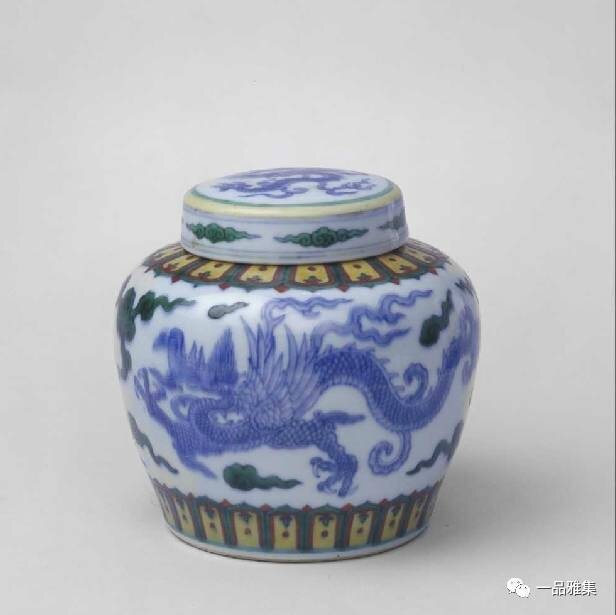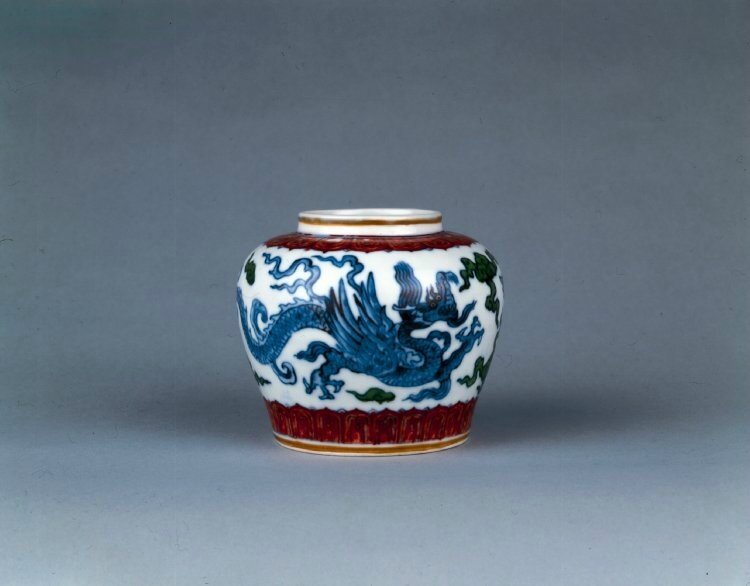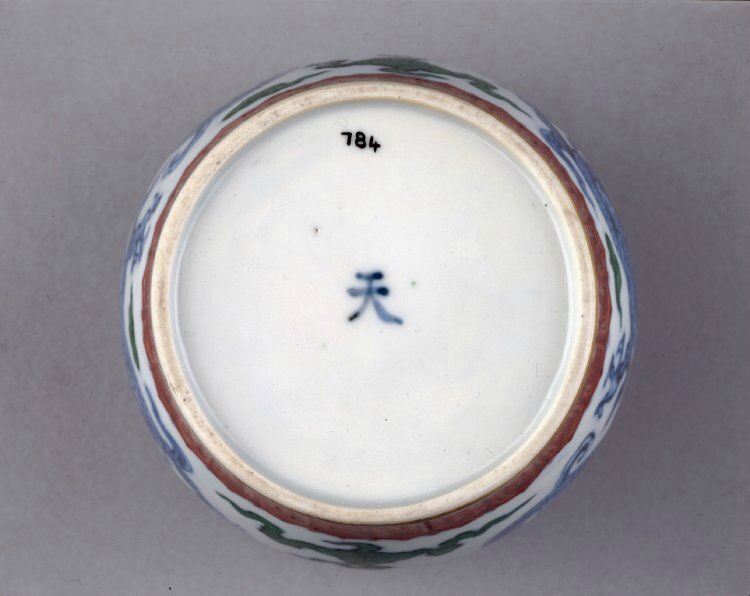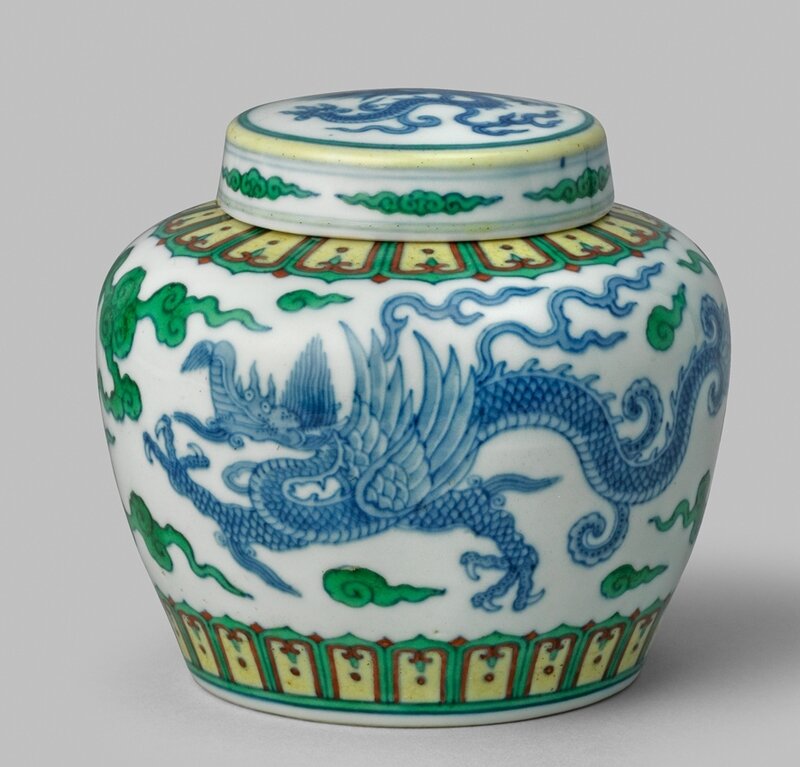A very rare Imperial Ming-style doucai 'dragon' jar, Yongzheng six-character mark and of the period (1723-1735)
Lot 21. A very rare Imperial Ming-style doucai 'dragon' jar, Yongzheng six-character mark and of the period (1723-1735); 10cm (3 7/8 in) high (3). Estimate HK$ 4,000,000 - 6,000,000 (€430,000 - 650,000). Sold for HK$ 4,900,000 (€528,330). Photo: Bonhams.
Elegantly potted with a tapering body raised on a slightly recessed foot, the creamy white body delicately outlined in a soft underglaze blue and finely enamelled in translucent green, yellow and iron-red with two three-clawed winged writhing dragons striding amidst undulating cloud wisps, all between two borders of lotus petal lappets, the top of the matched cover, 18th century, decorated with a front-facing five-clawed sinuous dragon amidst iron-red flames, fitted box.
Provenance: N.H.P. Huth
Sotheby's London, 26 April 1966, lot 132
W.W. Winkworth (1897-1991)
Sotheby's London, 12 December 1972, lot 119
Hugh Moss Ltd., London, acquired from the above sale
Christie's New York, 15 September 2011, lot 1543
An important Asian private collection.
William Wilberforce (Billy) Winkworth (1897-1991) was one of the greatest collectors of Chinese and Japanese works of art of his time. He was the son of Sir Stephen D. Winkworth (d.1938), an eminent collector of Chinese art and one of the founding members of the Oriental Ceramic Society. Billy Winkworth worked at the British Museum from 1919 to 1926 under the Keeper R.L. Hobson, later working part time at Sotheby's and Glendinnings; see R.Davids and D.Jellinek, Provenance, Oxon, 2011, pp.443-444.
Note: Only three other similar examples, Yongzheng mark and of the period, are presently known: the first such doucai guan jar in the Qing Court Collection, is illustrated in The Complete Collection of the Treasures of the Palace Museum: Porcelains in Polychrome and Contrasting Colours, Hong Kong, 2007, no.214.; the second, in the Victoria and Albert Museum, London, gifted by Mrs Julia C. Gulland in 1907, museum no.622-1907, is published by A.Hougron, La Céramique chinoise ancienne, Paris, 2015, p.212; and the third, was sold at Woolley and Wallis, Salisbury, 15 November 2016, lot 88.
A doucai guan jar, Yongzheng mark and period in the Qing Court Collection; image courtesy of the Palace Museum, Beijing
Jar, porcelain with dragon design decorated in underglaze blue and overglaze enamels in doucai style, China, Qing dynasty, Yongzheng mark and period (1723-1735). Height: 8.9 cm, Diameter: 10.8 cm. Given by Mrs. Julia C. Gulland, 622-1907 © Victoria and Albert Museum.
The present 'winged-dragon' jar stands as a tribute by the Yongzheng Emperor to the celebrated Imperial porcelain produced during the Chenghua reign. Both emperors are known for their exacting standards and personal involvement in the production process, resulting in the finest porcelain in form and design. The Yongzheng Emperor, though a Manchu, was a strong proponent of traditional Confucian thinking in Han Chinese culture, seeking to achieve cultural continuity. This was reflected in his support of the compilation of a history of the previous Ming dynasty, demonstrating the orthodoxy of Qing rule. His fascination with antiquity led him to repeatedly send antiques from the Palace to the kilns to serve as standards for quality, models for forms and designs and as inspiration for innovation; see Harmony and Integrity: The Yongzheng Emperor and His Times, Taipei, 2009, p.159; and E.S.Rawski and J.Rawson, eds., China: The Three Emperors 1662 – 1795., London, 2005, p.245. For two similar examples of a doucai 'winged-dragon' jar, bearing a tian character, Chenghua period, which provided the inspiration for the present lot, see one unearthed in Zhushan, Jingdezhen, illustrated in A Legacy of Chenghua, Hong Kong, 1993, pp.310-311, no.C111; and another in the Sir Percival David Collection, in the British Museum, London, illustrated by M.Medley, Illustrated Catalogue of Ming Polychrome Wares, London, 1978, pl.II, no.19.
Doucai jar with dragons, Ming dynasty, Chenghua mark and period, AD1465–87. Porcelain with underglaze cobalt-blue and overglaze enamel decoration, Jingdezhen, Jiangxi province, Sir Percival David Foundation of Chinese Art, PDF.784 © Trustees of the British Museum
Archaism in ceramics made by the Imperial kilns continued in the early Qianlong period under the supervision of Tang Ying. According to Tang Ying zouzhe, 'Memorials by Tang Ying', on the 19th day of the 6th month in the 9th year of the Qianlong reign (1743), Tang Ying received a Chenghua tian character jar and cover from the Palace Workshops, and was instructed to touch up the glaze flakes, but apprehensive of the possible detrimental outcome of firing an earlier piece in a contemporary kiln, Tang Ying instead had three pairs of jars and covers made in imitation of the original Chenghua prototype; see Yuan Tie, Qing gong ci qi dang an quan ji, vol.2, Beijing, 2008, p.294. For a very similar Yongzheng 'winged-dragon' lidded jar, but with a tian character mark, in the Shanghai Museum, see Lu Minghua, Ming Dynasty Ceramics, Studies of the Shanghai Museum Collections, Shanghai, 2007, p.299, fig. 5-37; and see a similar example, bearing a tian character mark, which was sold at Christie's Hong Kong, 27 November 2013, lot 3387.
A fine and rare small Ming-style doucai 'dragon' jar, Yongzheng-Qianlong period (1723-1795); 4 1/2 in. (11.5 cm.) wide. Sold for 3,160,000 HKD Christie's Hong Kong, 27 November 2013, lot 3387. © Christie's Images Ltd 2013
Bonhams. FINE CHINESE CERAMICS AND WORKS OF ART, 28 Nov 2017, 14:00 HKT, HONG KONG, ADMIRALTY
NDB: See also:
A rare Chinese imperial doucai jar and cover, Yongzheng mark and period (1723-1735) sold for £820,000 at Woolley & Wallis, 15 November 2016.
The jar came from a British private collection and the base had a paper label for Bluett & Sons in London where it was purchased in May 1946 for £9,10 shillings.
The 4in (10.4cm) high jar was painted in underglaze blue with two scaly yinglong(winged dragons) in flight amongst scrolling clouds. A band of scalloped lappets to the shoulder and foot were embellished with doucai enamels.

/https%3A%2F%2Fprofilepics.canalblog.com%2Fprofilepics%2F1%2F0%2F100183.jpg)
/https%3A%2F%2Fstorage.canalblog.com%2F03%2F02%2F119589%2F96711876_o.jpg)
/https%3A%2F%2Fstorage.canalblog.com%2F11%2F31%2F119589%2F94773502_o.jpg)
/https%3A%2F%2Fstorage.canalblog.com%2F20%2F83%2F119589%2F94772815_o.jpg)
/https%3A%2F%2Fstorage.canalblog.com%2F26%2F72%2F119589%2F75604929_o.jpg)
/https%3A%2F%2Fstorage.canalblog.com%2F59%2F60%2F119589%2F26458628_o.jpg)












/image%2F1371349%2F20240326%2Fob_936d86_104-1.jpg)
/image%2F1371349%2F20240326%2Fob_823710_102-1.jpg)
/image%2F1371349%2F20240326%2Fob_55a293_101-1.jpg)
/http%3A%2F%2Fstorage.canalblog.com%2F33%2F99%2F119589%2F129627838_o.jpg)